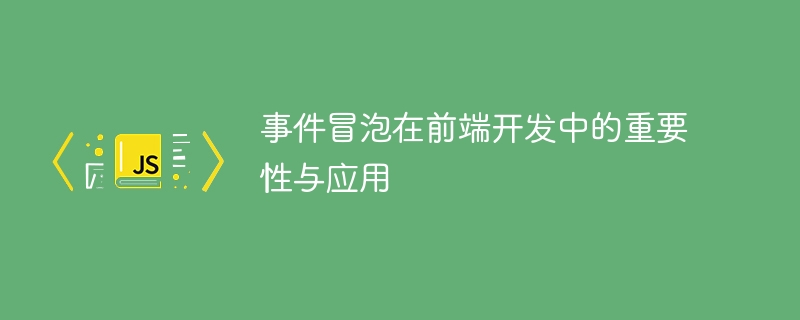Home >Web Front-end >JS Tutorial >The importance and application of event bubbling in front-end development
The importance and application of event bubbling in front-end development
- WBOYWBOYWBOYWBOYWBOYWBOYWBOYWBOYWBOYWBOYWBOYWBOYWBOriginal
- 2024-01-13 09:03:071106browse

The importance and application of event bubbling in front-end development
Event bubbling is a very important concept in front-end development. It can realize the delivery and application of events. Handling, provides a convenient mechanism to handle interactive operations on the page. This article will introduce the principle and application scenarios of event bubbling in detail, and give specific code examples.
1. The principle of event bubbling
Event bubbling means that in the DOM tree, when an element triggers an event, the event will be transmitted in the order from the bottom element to the top element and Triggered until processed or bubbled to the top element.
For example, there is a div that contains multiple nested elements. When one of the child elements is clicked, the event it triggers will bubble up, triggering the same event on its parent element step by step. events up to the root element. In this way, we only need to listen for events on the root element and be able to handle events on all child elements.
The principle of event bubbling provides us with a very flexible and efficient event processing method, which can simplify the code structure and improve the maintainability of the code.
2. Application scenarios of event bubbling
- Unified event processing
Through event bubbling, we can bind the event processing function to the common parent element, thus Implement unified event processing for child elements. In this way, we do not need to bind event handling functions to each child element, which reduces the amount of code and improves code efficiency. - Event delegation
Event delegation is an important application of event bubbling. It can bind an event handler to a parent element and trigger event processing functions on child elements through event bubbling. This allows you to dynamically add and delete child elements without rebinding event handlers, which greatly simplifies the code. - Improve performance
Through event bubbling, we can reduce the number of bindings of event processing functions, thus improving performance. Because event bubbling is triggered on the underlying element, only one event handler is needed to handle events for multiple child elements.
3. Code example of event bubbling
In order to better understand the application of event bubbling, let’s look at a specific code example.
HTML part:
<div id="wrapper">
<div class="item">
<span>1</span>
</div>
<div class="item">
<span>2</span>
</div>
<div class="item">
<span>3</span>
</div>
</div>CSS part:
.item {
width: 100px;
height: 100px;
background-color: pink;
display: flex;
align-items: center;
justify-content: center;
cursor: pointer;
}
.item span {
color: white;
font-size: 24px;
}JS part:
document.getElementById("wrapper").addEventListener("click", function(event) {
if (event.target.classList.contains("item")) {
alert("你点击了第" + event.target.children[0].innerText + "个元素");
}
});In the above example, we bound click to the parent element wrapper Event handler function. When the sub-element item is clicked, due to the event bubbling mechanism, the click event will bubble upward, eventually triggering the handler function on the wrapper.
In the processing function, we can determine which sub-element was clicked by judging event.target and handle it accordingly. In this way, no matter which item we click, the corresponding prompt box will pop up.
Through this simple example, we can clearly see the convenience of event bubbling and how it can be flexibly applied to actual page development.
Conclusion: Event bubbling plays a very important role in front-end development. It can simplify the code structure, improve code efficiency, and enable us to better handle interactive operations on the page. I hope this article can help readers better understand the principles and applications of event bubbling, and be able to flexibly apply it to their own projects.
The above is the detailed content of The importance and application of event bubbling in front-end development. For more information, please follow other related articles on the PHP Chinese website!
Related articles
See more- An introduction to how javascript prevents event bubbling and browser default behavior
- Comparison of similarities and differences between several web front-end development frameworks
- The Importance of Ethics and Governance for Artificial Intelligence
- How to use event modifier .stop in Vue to stop event bubbling

